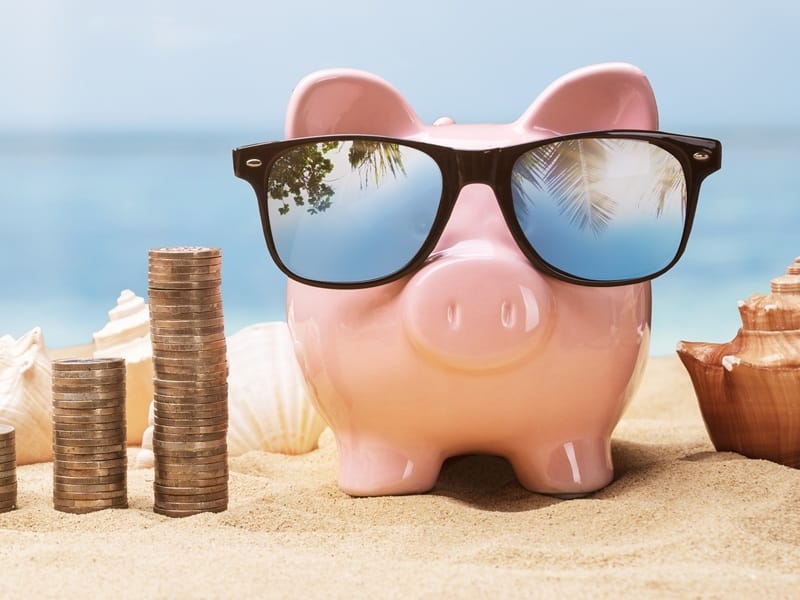- The Wealth Expedition
- Posts
- 1 Simple Habit to Stay Out of Debt
1 Simple Habit to Stay Out of Debt
Is there a way to set up an automatic plan to avoid nearly every future financial emergency? This simple habit can change your day-to-day life.

Our weekly newsletter features the following sections:
News
Paradigm Shift
Financial Tool
Here’s How I Can Help
First time reading? Subscribe for weekly content here.
A big thank you to 1440 Media for sponsoring today’s newsletter!
Receive Honest News Today
Join over 4 million Americans who start their day with 1440 – your daily digest for unbiased, fact-centric news. From politics to sports, we cover it all by analyzing over 100 sources. Our concise, 5-minute read lands in your inbox each morning at no cost. Experience news without the noise; let 1440 help you make up your own mind. Sign up now and invite your friends and family to be part of the informed.

“I learned this, at least, by my experiment: that if one advances confidently in the direction of his dreams, and endeavors to live the life which he has imagined, he will meet with a success unexpected in common hours.”
-Walden by Henry David Thoreau
Check out the second podcast episode on YouTube!

NEWS
What Happened Last Week
Investor sentiment, while still fearful, improved slightly this past week according to the AAII Investor Sentiment Survey.
Sentiment overall is down over the past three months, however, hitting the lowest point at 57 since the November 2022 reading showed 56.7 according to the US Michigan Consumer Sentiment measure.
February’s core Personal Consumption Expenditure (PCE), an inflation measure, showed 0.4% instead of the expected 0.3%.
February’s consumer spending reported lower than expected, 0.4% versus the forecasted 0.5%.
The labor market showed strength as weekly initial unemployment claims reported 1,000 less than expected at 224,000.
New single-family home sales rose 1.8% in February (slightly below expectations), but the Pending Home Sales Index (a forward-looking indicator) showed a 2% gain.
Orders of durable goods (e.g. furniture, technology, cars, appliances, and other items lasting longer than 3 years) unexpectedly rose 0.9% in February, well ahead of expectations for a 1% decline. This surprise is likely due to continued front-loading to get ahead of tariffs.
The S&P 500 remains below its 50- and 200-day moving averages, indicating a higher likelihood of above-average short-term volatility.
The 50-day moving average remains above the 200-day moving average, and the monthly Relative Strength Indicator (RSI) remains above 50, both which indicate the upward trend has not yet clearly reversed.
How I See It
This past week has been one of mixed signals. Good news followed by bad news.
Strong labor markets, strengthening housing markets, strong orders of durable goods.
Weaker-than-expected consumer spending, higher delinquency rates, higher inflation.
At this point, there is so much change occurring that no one knows how to predict what things will look like by the end of 2025.
But from a more aerial view of the markets, aside from the reasons given for recent volatility, this appears very on par with normal market activity.
The initial boost of business optimism from the election year often gives way to a more grounded view in the first year of a Republican President’s term.
A very high price-to-earnings ratio (particularly the Shiller P/E) cannot afford to sustainably grow at such high rates as the past two years without creating increased potential for a bubble to develop. I believe anything beyond market growth of 15% for 2025 would be pushing levels uncomfortably high, given the current economic data available.
Tariff talk, like in 2018, has created a reaction in investor sentiment.
It wouldn’t be unusual to see a bear market develop this year:
Bear markets statistically develop more often during the first half of a US President’s term.
The latest bear market in 2022 was not accompanied by a recession, and similar precedents in history show a tendency toward a shorter-than-average bull market afterward.
The Shiller P/E is very high, which doesn’t reveal the timing of the next bear market, but does often predict lower ten-year forecasted market growth.
Yet, in today’s environment, nothing material has happened except heightened uncertainty over the impact of tariffs. And if there’s anything markets overreact to, it’s uncertainty.
Fundamentally, there’s just not a lot of reason to be overly bearish in an environment where 52% of investors expect a bear market in the next six months due to…nothing particularly convincing.
I’ve discussed in previous newsletters why tariffs are not likely to be a recession-inducing inflationary monster. And if that’s true, then a lot of this fear is simply discounting stocks for another likely run upward to make 2025 a positive year.

PARADIGM SHIFT
1 Simple Habit to Stay Out of Debt
As an investor, it’s tempting to overlook the money market account.
After all, there’s no chance it’s going to change your life overnight, right?
But maybe that’s not entirely true.
If used right, this can set you up for automatic success in maintaining a balanced budget.
When I was an advisor, I can’t tell you how many times clients underestimated their expenses because they were only considering their recurring, habitual expenses. But when it came time to buy a new car, renovate the kitchen, replace the roof, etc., they came to me with a “one-time” expense that they assured me would not be repeated.
Yet a few months later, they were back again needing money for the next “one-time” expense. This pattern disrupts the ability to take on proper risk while also increasing the likelihood of turning to debt for the answer.
Have you noticed how often we get these one-time expenses? Multiple times a year! Usually at least one a month!
Before we know it, we’re either drawing too much from savings or, worse, accumulating debt to pay for these surprises.
There’s a simple way to avoid being caught off guard. Pay yourself first.
Think of yourself as a government or a business. It’s your job to take care of all of yourself: past, present and future. But for that, you must have a reasonable estimate of potential future outcomes and their costs.
It’s may sound simple and common sense, but if you do this, you’ll rarely if ever experience a true financial emergency that requires you to fall into debt.
Start with these categories:
Housing (repairs, maintenance, renovations, furniture, appliances)
Clothing
Transportation (oil change, tire change, repairs, license, tax, car replacement)
Medical (doctor, dentist, optometrist, chiropractor, therapist, medicine)
Recreation (vacations)
Personal (gifts, school supplies, etc.)
Then follow these three steps:
Review the past 12 months of spending for each overall category.
Divide the full cost by 12.
Set up an automatic monthly cash sweep of this number to a money market account.
It’s important to keep this money market account separate from your normal spending account! This creates a clear distinction beyond just maintaining the mental accounting in your head. And it also creates a barrier to spending the money without thought.
Here’s good news. If 12 months goes by, and you have not drawn from the account for a specific category, you can reduce your monthly sweep by that category’s amount. It’s fully funded.
If you underestimated expenses for one category, increase the sweep to meet the new expectations.
The money market account suddenly becomes far more interesting and relevant to your financial picture. It changes how you live in the here and now.
This is not an emergency fund. This is an account which you know you’re going to pull from. The question simply is when.
By placing this cash sweep on automatic, and using historical statistics to estimate future expenses, you keep yourself out of debt. And freedom from debt sets you upon a solid foundation from which you can begin accumulating wealth far beyond today’s needs.


FINANCIAL TOOL
Laddered CDs
When we’re working and earning, Certificates of Deposit may not sound all that exciting.
After all, our emergency fund needs to be liquid. And so does our fund for occasional expenses (like house repairs, car maintenance, etc.). At least, for the most part.
But like a bank, we also know with a fair degree of reasonable certainty that not ALL of our occasional expenses are going to come due all at the same time. Banks are reasonably certain that not all of their depositors are going to come asking for full withdrawals all at once.
In the same way, we know that, while it’s possible, it’s not probable that our car will break down at the same time our roof needs replacement while we rack up a surprise medical cost and decide to take an overseas vacation all within the same quarter.
It might happen, but not likely often, if ever. If it does, that’s what the emergency fund is for. But the fund for occasional expenses can be more versatile in how we invest it.
Like a bank, we can loan out some of our reserves in the form of purchasing CDs. But the best CD rates often come with the longest lock-up period. So how do we keep enough liquidity while still capturing that higher interest rate?
Most of the time, the yield curve is upward sloping. That means, shorter duration fixed income is going to pay a lower interest rate than those with longer durations. That’s not always the case, particularly when recession appears likely, but it’s the normal state of interest rates.
With this in mind, here’s an example of laddering CDs.
Let’s say a 3-month CD is paying 4%. But a 12-month CD is paying 4.6%. We want that higher rate.
Assume we have $16,000 saved away in our “occasional expenses” fund and $20,000 saved in our emergency fund.
The emergency fund stays liquid, usually in something like a money market account.
But the occasional expenses fund can be laddered like this. Every three months, we can place $4,000 into a 12-month CD. After 12 months have passed, we now have 4 sets of $4,000 earning the one-year rate.
And $4,000 becomes liquid every three months, at which point we can reinvest back into another 12-month CD or use it if needed.
In the meantime, if an expense comes up that requires a withdrawal from savings, we can temporarily draw from the emergency fund and replenish that amount when the next CD comes up for renewal.
While this is a specific example, just think of what 4.6% on a $16,000 cash amount would mean: $736 after a 12-month period! Of course, this oversimplifies the fact that 12-month interest rates would be constantly changing with each renewal.
But $700+ easily pays for a variety of possible expenses, from car maintenance to hotel costs during vacation.
This constitutes very short-term investing. And while it may not make us rich, it can easily make an impact upon our ability to meet additional expenses during a year!

HERE’S HOW I CAN HELP
Launch Your Personal Wealth Expedition!
Ready to take control of your financial destiny?
Here are the two foundational courses which will set you on course to radically transform the way you live and work.

Budget, Build, Bridge: The Roadmap to Financial Independence
This course will lead you step-by-step toward developing your escape plan into a life of comprehensive wealth: time, flexibility, purpose and money.
Each lesson builds upon the last, covering these main topics:
Master high-impact budgeting techniques to create a surplus today.
Develop a plan to become debt-free in record time.
Raise your salary this year.
Use tax strategy to fast-track your goals.
Bridge your way to entrepreneurship.

Advanced Investing for Financial Freedom
Whether you're new to investing or a seasoned expert, this course is designed to make anyone a master of what I believe to be the most important investing concepts.
Here's what you'll learn in this course.
The foundational concepts for analyzing the risk and performance of mutual funds and ETFs.
How your goals affect the allocation of your investment portfolio.
How to fine tune the risk factors in your portfolio to weight the odds of success in your favor.
How to identify stages of the market cycle and build your portfolio around it.
How, when and why to hedge against downside risk.
How this all ties together as one comprehensive wealth expedition from ground zero to financial independence.
With investing, it often takes an understanding of just a handful of concepts to make all the difference in your ability to make tremendous wealth over time.
My goal with this course is to offer you what I see as the most important concepts to successful investing, setting you on course to achieve your dream life well in advance of retirement age using simple but powerful habits of finance.

How did you like today's newsletter?I'm always looking for ways to offer greater value to fellow explorers. Your feedback helps set the direction for future content! |

I’d love to hear from you. Let me know what you’d like to see in upcoming newsletters, articles, or a digital course at Contact Us - The Wealth Expedition.


